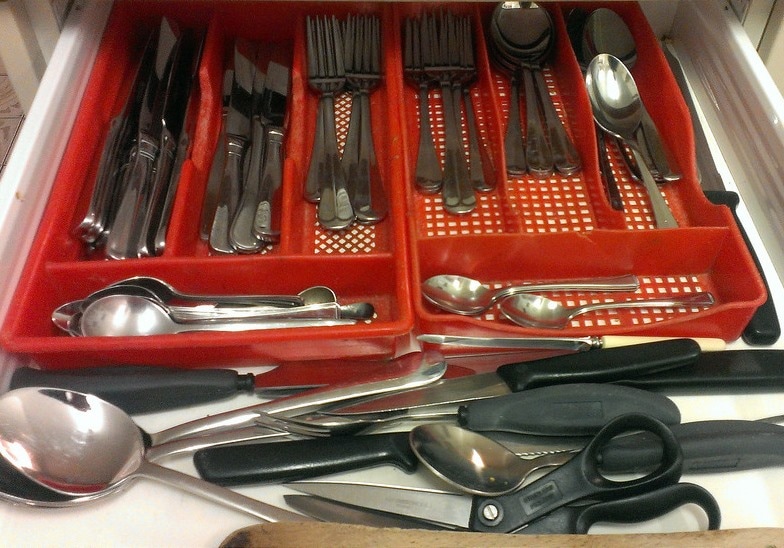Any kitchen needs drawers to store the small items that you need on a regular basis: cutlery, scissors, aluminium foil, plastic bags, ice cube holders, ladles, tea sieves, chop sticks, straws, skewers, oven mitts, place mats, napkins, etc. Apart from that, kitchen drawers seem to attract all kinds of other stuff that does not necessarily have to be in the kitchen, like rubber bands, safety pins, spare keys, that thing to rid your radiators of air, bicycle repair kit, first aid stuff, tissues, odd bits of headphones, phone charger, that stone you found on the beach, … bits and bobs, really. And don’t pretend you do not have such drawers in your kitchen, because you do! In order to declutter your drawers, do not simply take out what you think is in the wrong place. It is imperative that you empty the drawers completely as this not only forces you to consider every single item, group them and discard superfluous ones, but it also allows you to clean the drawer properly. And I bet you’ll find that they need cleaning! Since there is a likelihood you will find similar items in different drawers, it is a good idea to clear out all of them at once, if you have enough space to put everything down and sort properly. The first step in decluttering those drawers is to make sure that nothing remains that is not kitchen-related. Out of the above list, that would include spare keys, bicycle repair, electronics, stones, … to name just a few. Stick to things related to preparing and storing food. Anything else has no place in the kitchen!
Once you have eliminated those non-kitchen items, you will be left with piles of things that need looking at more closely. Try to sort them into categories like “knives”, “ladles”, etc. You will most likely be confronted with a multitude of items that you have more than one of. Don’t get me wrong: of course you need more than one spoon, fork and knife! I’m thinking of the 7 skillets and 5 ladles, the collection of measuring cups, and the like. The items you use occasionally for specific tasks. If you only ever use the same skillet and ladle, there is a point to be made that the others are not really necessary. Keep a working one, and maybe one more, but get rid of the rest. Believe me: you will not miss them. Keep going through all the items and discard what you feel you have not used in a while and have more than one of.
So far, we have only looked at items that obviously have no place in your kitchen, but this is where things get interesting. Do you really need those spaghetti tongs? How often do you actually use that egg separator? Why do you keep all that plastic cutlery? Many of these specialist items are really just taking up space! Indeed, spaghetti tongs are useful, but you can do the same thing with two forks, as Italian woman have done for hundreds of years. Eggs can be separated very simply without a tool that sometimes works and sometimes doesn’t, just using the old-fashioned method of pouring the egg from one half of the shell into the other. If you really give it some thought, many of those clunky gadgets in your drawers are really just fancy, rarely used novelty items. As for the plastic cutlery: it usually comes with take-out food and you keep it because “it might come in handy someday”. Dump it: you do have proper cutlery in another drawer!
Now that you have removed items and have sorted the remainder, it is time to put them back into your drawers. But hold your horses, do not simply put things where they were: take a moment to think just where you normally use them! Of course, cooking items like skillets or ladles need to be near the stove, and cutting knives should be somewhere near to where you prepare your food. The eating cutlery goes somewhere near the place you eat or where the plates are located. Use drawers near the area you are likely to use those items. This strategy applies in any kitchen small or large. Not only will you have what you need nearby, but also you’ll save time and bother when you are busy.
All these items have one thing in common: they have irregular sizes, are relatively small, and tend to slip around whatever you put them in. It takes a very short time for items to dislodge themselves and move around in a drawer as you pull it out and push it in all the time. It is paramount that you have a system inside your drawers that prevents small items from moving around. That system does not need to be sophisticated, custom-made stuff: empty cardboard packaging (e.g. cereal boxes) are ideal and can be quickly cut to size, if necessary. And you can put shoe boxes, old cooking tins, and such things to good use. Just be creative about it, no need to spend money on that: it’s going to be inside your drawer anyway! As always, an important part of staying clutter free is to make sure that each item has a ‘home’. This is a simple concept for larger items, and I am fully aware that this idea feels somewhat alien for those small kitchen items. Still: think of it in terms of those storage boxes: every box is a home for a class of items, and if you make sure they go back where they belong as quickly as possible, your kitchen drawers will remain useful for a long time. The storage area ‘homes’ have another side effect: if one of those is overflowing, you may want to review the key points about “keeping too many of the same kind” and “is it really necessary?”. If you have enjoyed reading this, you may find these other articles interesting: Comments are closed.
|
Ask the ClutterMeisterIdeas to help clear away the mess in your homes and in your minds.
Feel free to share any of my posts, but please put in a backlink to the original blog post. Thank you. The author
Hi, my name is Tilo Flache. My mission: help clients declutter mind and space.
This blog contains pointers for your journey towards a happier living experience. Archives
November 2023
|




 RSS Feed
RSS Feed




